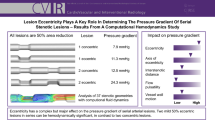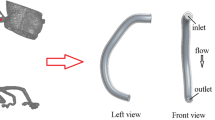Abstract
Saphenous vein graft (SVG) bypass placement is regarded as the optimal option for renal artery stenosis, which usually causes secondary hypertension and poor renal perfusion. Using computational fluid dynamics, this study aimed to investigate the underlying hemodynamic mechanism of the vein aneurysm and stenosis after aortorenal bypass surgery. Three-dimensional models were reconstructed based on computed tomographic angiography images of a 20-year-old female patient who suffered from uncontrollable hypertension using the image processing package Mimics (Materialise). The morphology and hemodynamic parameters in the healthy state, at initial presentation and at post-operative 9-month and 2-year follow-ups after surgery were analysed. The hemodynamic parameters became normal in the left and right renal arteries after bypass surgery. However, flow separation and stagnation occurred at the post-operative 9-month aorta-vein anastomosis, which caused asymmetrical flow and extremely high wall shear stress (WSS) and WSS gradients at the outflow vein tract, where the stenosis occurred 2 years later. In addition, the graft bending produced an asymmetrical flow pattern downstream. This research revealed that the abnormal hemodynamics, including flow separation and extremely high WSS values and gradients, caused by the retrograde flow of aortorenal bypass may be responsible for the SVG degeneration. In addition, flow asymmetry due to vessel bending is a potential risk factor for SVG aneurysm dilation.









Similar content being viewed by others
References
Alimohammadi M, Agu O, Balabani S, Diaz-Zuccarini V (2014) Development of a patient-specific simulation tool to analyse aortic dissections: assessment of mixed patient-specific flow and pressure boundary conditions. Med Eng Phys 36:275–284
Almanaseer Y, Rosman HS, Kazmouz G, Giraldo AA, Martin J (2005) Severe dilatation of saphenous vein grafts: a late complication of coronary surgery in which the diagnosis is suggested by chest x-ray. Cardiology 104:150–155
Asif A, Lenz O, Merrill D, Cherla G, Cipleu CD, Ellis R, Francois B, Epstein DL, Pennell P (2006) Percutaneous management of perianastomotic stenosis in arteriovenous fistulae: results of a prospective study. Kidney Int 69:1904–1909
Ballarin F, Faggiano E, Manzoni A, Quarteroni A, Rozza G, Ippolito S, Antona C, Scrofani R (2017) Numerical modeling of hemodynamics scenarios of patient-specific coronary artery bypass grafts. Biomech Model Mechanobiol 16:1373–1399
Bath J, Cho JS (2012) Aneurysm of a 32-year-old aortorenal saphenous vein bypass graft. Ann Vasc Surg 26:1128-e7
Beathard GA (1994) The treatment of vascular access graft dysfunction: a nephrologist's view and experience. Adv Ren Replace Ther 1:131–147
Beathard GA, Arnold P, Jackson J, Litchfield T, Physician Operators Forum RMS Life (2003) Aggressive treatment of early fistula failure. Kidney Int 64:1487–1494
Carroll GT, McGloughlin TM, Burke PE, Egan M, Wallis F, Walsh MT (2011) Wall shear stresses remain elevated in mature arteriovenous fistulas: a case study. J Biomech Eng Trans ASME 133:021003
Cheng Z, Tan FPP, Riga CV, Bicknell CD, Hamady MS, Gibbs RGJ, Wood NB, Xu XY (2010) Analysis of flow patterns in a patient-specific aortic dissection model. J Biomech Eng Trans ASME 132:051007
Fan T, Lu Y, Gao Y, Meng J, Tan W, Huo Y, Kassab GS (2016) Hemodynamics of left internal mammary artery bypass graft: effect of anastomotic geometry, coronary artery stenosis, and postoperative time. J Biomech 49:645–652
Figueroa CA, Taylor CA, Chiou AJ, Yeh V, Zarins CK (2009) Magnitude and direction of pulsatile displacement forces acting on thoracic aortic endografts. J Endovasc Ther 16:350–358
Fitts MK, Pike DB, Anderson K, Shiu YT (2014) Hemodynamic shear stress and endothelial dysfunction in hemodialysis access. Open Urol Nephrol J 7:33–44
Friedman MH, Bargeron CB, Duncan DD, Hutchins GM, Mark FF (1992) Effects of arterial compliance and non-Newtonian rheology on correlations between intimal thickness and wall shear. J Biomech Eng 114:317–320
Hansen KJ, Deitch JS, Oskin TC, Ligush J, Craven TE, Dean RH (1998) Renal artery repair: consequence of operative failures. Ann Surg 227:678–690
Hathcock JJ (2006) Flow effects on coagulation and thrombosis. Arterioscler Thromb Vasc Biol 26:1729–1737
Huang B, Yuan D, Zhao J, Ma Y (2012) Hybrid treatment of a thoracoabdominal aortic aneurysm in China: report of the first successful case. Surg Today 42:1219–1224
Huo Y, Luo T, Guccione JM, Teague SD, Tan W, Navia JA, Kassab GS (2013) Mild anastomotic stenosis in patient-specific CABG model may enhance graft patency: a new hypothesis. PLoS ONE 8:e73769
Jou LD, Saloner D (1998) A numerical study of magnetic resonance images of pulsatile flow in a two dimensional carotid bifurcation: a numerical study of MR images. Med Eng Phys 20:643–652
Kabinejadian F, Su B, Ghista DN, Ismail M, Kim S, Leo HL (2017) Sequential venous anastomosis design to enhance patency of arterio-venous grafts for hemodialysis. Comput Methods Biomech Biomed Eng 20:85–93
Les AS, Shadden SC, Alberto Figueroa C, Park JM, Tedesco MM, Herfkens RJ, Dalman RL, Taylor CA (2010) Quantification of hemodynamics in abdominal aortic aneurysms during rest and exercise using magnetic resonance imaging and computational fluid dynamics. Ann Biomed Eng 38:1288–1313
Liu X, Gao Z, Xiong H, Ghista D, Ren L, Zhang H, Wu W, Huang W, Hau WK (2016) Three-dimensional hemodynamics analysis of the circle of Willis in the patient-specific nonintegral arterial structures. Biomech Model Mechanobiol 15:1439–1456
Machi P, Ouared R, Brina O, Bouillot P, Yilmaz H, Vargas MI, Gondar R, Bijlenga P, Lovblad KO, Kulcsar Z (2019) Hemodynamics of focal versus global growth of small cerebral aneurysms. Clin Neuroradiol 29:285–293
Majeski J (2004) Replacement of in situ saphenous venous aneurysms with arterial autografts. Am J Surg 188:168–170
Marone LK, Clouse WD, Dorer DJ, Brewster DC, LaMuraglia GM, Watkins MT, Kwolek CJ, Cambria RP (2004) Preservation of renal function with surgical revascularization in patients with atherosclerotic renovascular disease. J Vasc Surg 39:322–329
Marrocco-Trischitta MM, van Bakel TM, Romarowski RM, de Beaufort HW, Conti M, van Herwaarden JA, Moll FL, Auricchio F, Trimarchi S (2018) The modified arch landing areas nomenclature (MALAN) improves prediction of stent graft displacement forces: proof of concept by computational fluid dynamics modelling. Eur J Vasc Endovasc Surg 55:584–592
Pandey P, Rayes M, Hong D, Guthikonda M, Xavier A (2011) Endovascular management of a giant aneurysm through saphenous vein graft after extracranial-intracranial bypass: case report and literature review. J Neurointerv Surg 3:361–363
Perktold K, Peter RO, Resch M, Langs G (1991) Pulsatile non-Newtonian blood flow in three-dimensional carotid bifurcation models: a numerical study of flow phenomena under different bifurcation angles. J Biomed Eng 13:507–515
Qiu Y, Wang Y, Fan YB, Peng LQ, Liu R, Zhao JC, Yuan D, Zheng TH (2019) Role of intraluminal thrombus in abdominal aortic aneurysm ruptures: a hemodynamic point of view. Med Phys 46:4263–4275
Shahcheraghi N, Dwyer HA, Cheer AY, Barakat AI, Rutaganira T (2002) Unsteady and three-dimensional simulation of blood flow in the human aortic arch. J Biomech Eng Trans ASME 124:378–387
Travis JA, Hansen KJ, Miller PR, Dean RH, Geary RL (2000) Aneurysmal degeneration and late rupture of an aortorenal vein graft: case report, review of the literature, and implications for conduit selection. J Vasc Surg 32:612–615
Tse KM, Chiu P, Lee HP, Ho P (2011) Investigation of hemodynamics in the development of dissecting aneurysm within patient-specific dissecting aneurismal aortas using computational fluid dynamics (CFD) simulations. J Biomech 44:827–836
Wen J, Yuan D, Wang QY, Hu Y, Zhao JC, Zheng TH, Fan YB (2016) A computational simulation of the effect of hybrid treatment for thoracoabdominal aortic aneurysm on the hemodynamics of abdominal aorta. Sci Rep 6:23801
Xiao N, Alastruey J, Figueroa CA (2014) A systematic comparison between 1-D and 3-D hemodynamics in compliant arterial models. Int J Numer Method Biomed Eng 30:204–231
Xu P, Liu X, Zhang H, Ghista D, Zhang D, Shi C, Huang W (2018) Assessment of boundary conditions for CFD simulation in human carotid artery. Biomech Model Mechanobiol 17:1581–1597
Zhang JM, Zhong L, Su B, Wan M, Yap JS, Tham JP, Chua LP, Ghista DN, Tan RS (2014) Perspective on CFD studies of coronary artery disease lesions and hemodynamics: a review. Int J Numer Method Biomed Eng 30:659–680
Zhao X, Liu Y, Li L, Wang W, Xie J, Zhao Z (2016) Hemodynamics of the string phenomenon in the internal thoracic artery grafted to the left anterior descending artery with moderate stenosis. J Biomech 49:983–991
Funding
This study was supported in part by the National Natural Science Foundation of China [No. 11802253].
Author information
Authors and Affiliations
Corresponding authors
Ethics declarations
Conflict of interest
The authors declare that they have no competing interests.
Additional information
Publisher's Note
Springer Nature remains neutral with regard to jurisdictional claims in published maps and institutional affiliations.
Rights and permissions
About this article
Cite this article
Xiong, Z., Wang, Y., Mou, Z. et al. Longitudinal computational fluid dynamics study of stenosis and aneurysmal degeneration of an aortorenal bypass. Biomech Model Mechanobiol 19, 1965–1975 (2020). https://doi.org/10.1007/s10237-020-01320-9
Received:
Accepted:
Published:
Issue Date:
DOI: https://doi.org/10.1007/s10237-020-01320-9




